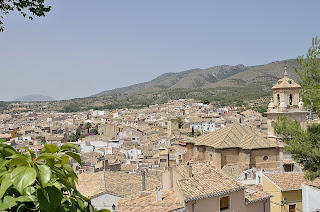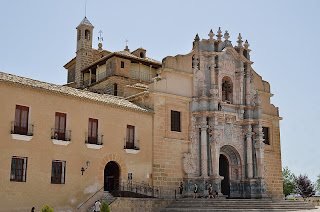On Saturday I took a drive to Caravaca de la Cruz. Caravaca is a medieval city with a long history of conflict between the Moors and the Christian kings of Spain. It has, of course, been witness to the tumultuous history of Spain over the last five centuries.
The city is best known for the Santuario de la Vera Cruz. The present structure was built in the early 1800s on the site of a former Moorish fort.
You can see an example of the double arm Caravaca cross above the door.
Click to enlarge.

These pictures from the 16th and 17th century chronicle the story of the Vera Cruz or True Cross.
I'll paraphrase the story. In 1232, May 2 to be exact, the Moorish king was speaking to prisoners at the castle on this site. One of the prisoners said he was a priest. The king said he'd like to see the priest perform a mass. So they rounded up some vestments and then the priest began. All of a sudden he stopped when he realized he didn't have a cross.
Suddenly two angels came through the window carrying a double arm cross made from the cross on which Christ was crucified. All were amazed, of course. The Moorish king was so moved that he converted to Christianity. Things get a little fuzzy for me about the history of this relic for the next 700 years but it was apparently stolen in 1934. Pope Pious XII gave the church two splinters form the Lignum Crucis in 1942 to replace the stolen cross.
You can get more details here ---> History of the Caravaca Cross
This a side view of the sanctuary from the museum.

Here is a view of the old quarter from the fortress area at the top of the hill.

These old towns are fascinating to visit. Not sure I'd want to live in one, though. Very narrow streets, small living spaces, people walking or driving just outside your door or window.
This is the other side of the sanctuary.
As I read a little bit about the history of Spain I was struck by the constant wars, political instability, etc. not to mention frequent outbreaks of the plague, yellow fever, etc. that decimated the population.
Even this door looks old.
This church was granted Holy City status by the Pope John Paul II in 1998. It is one of 5 Holy Cities in the world along with Rome, Jerusalem, Santiago de Compostela and Santo Toribio de Liebana.

This is another museum. I didn't have a chance to visit this one. It was closed from 2:00 PM to 4:00 PM for lunch.
You can get a sense of the streets here, also.

On the way back to Murcia, I drove through Calasparra. This is another old town. This fortification is actually a Christian fort built shortly after the Moors were chased out of this area. Like Lorca, it acted as a fortress against the Moors still in Granada.
You can learn more here. ---> History of Calasparra
We passed this marble quarry between Caravaca and Calasparra. For a mile or so the mountain was carved up on one side of the road and a series of marble factories were on the other side.
Here are a couple of miscellaneous pictures.
Ok, this is a test. Who can identify this tree?
Put your answer or guess in the comments below.
I'll post the answer in a few days.
I thought this was sort of ironic. This is in the suburbs of Cartagena. It is a nice sort of river walks. There are picnic tables, walking path, etc. Only one problem, no water in the river. These tend to be more like drainage canals - dry until it rains then they run full for a day or two.








Peaches Uncle Chip
ReplyDeletealmond Dana
ReplyDeleteMisheil sez: olive tree. What do we win?
ReplyDeleteYou will win nothing. Wrong answer. Correct one tomorrow. Get your answers in.
DeleteI guess I should mention that the correct answer wins nothing, also. Unless you count the pride that comes from being smarter than everyone else in the family.
DeleteDana wins! Dana wins! Yes, that is an almond tree.
ReplyDeleteIt helped that when I clicked to enlarge that the title said almond tree - not that I wouldn't have known anyway.
ReplyDelete